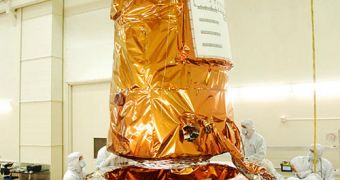Scientists managing the recently launched NASA planet-tracking telescope Kepler announce that the observatory suffered another safe-mode event on February 2. This is the fourth such event to plague the instrument since it was deployed, on May 12, 2009. Such occurrences are not normal, and the protective mode is engaged only when the spacecraft's computers experience an anomaly. Kepler was pulled off the safe-mode on February 5, and experts announce that no data were lost during the incident. Everything the telescope captured up to that point was safely downloaded to servers on Earth.
As the spacecraft engaged its built-in protective measures, it pointed its solar panels directly at the Sun, so as to benefit from the largest amount of solar energy possible, and also began to rotate slowly along a Sun-aligned axis. Furthermore, in order to prevent glitches with auxiliary systems, Kepler also shut down some of its auxiliary and redundant systems, including a photometer, and both of its star trackers. Early analyses of the telemetry the spacecraft sent back right before and during the incident seem to point at a fault in the star trackers, which apparently sent errant data to the ship's computers.
This forced the onboard software to trigger the safe mode, Space Fellowship reports. Engineers managing the mission said that the data the telescope had collected since January, when the last transfer of science took place, was safely retrieved as recovery operations were taking place, via the NASA Deep Space Network. The experts also added that they planned at least 12 days per year in which Kepler would not be sending back data due to similar glitches. They explained that the next download of science data was scheduled for mid-March 2010.
In the meantime, experts are busy analyzing all telemetry data they have available, in order to determine a possible cause for this malfunction, and also to develop potential mitigation solutions for the ill-effects the safe-mode may have caused. Kepler is one of the most advanced telescopes ever flown by NASA, and its purpose is to detect Earth-sized exoplanets orbiting distant stars. The way it does that is by analyzing the very slight fluctuation in brightness that individual stars exhibit as planets pass in front of them.

 14 DAY TRIAL //
14 DAY TRIAL //